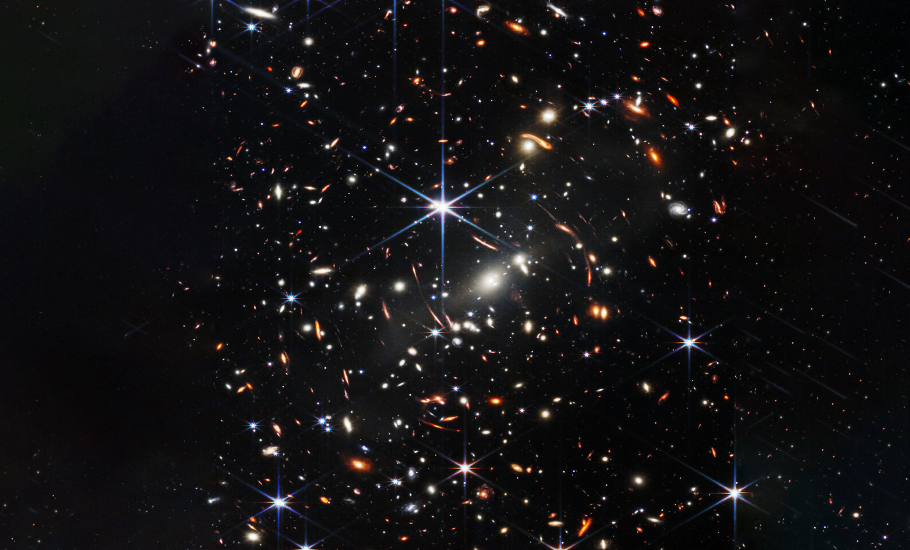
- Home
- News
- Analysis
- States
- Perspective
- Videos
- Education
- Entertainment
- Elections
- Sports
- Features
- Health
- Budget 2024-25
- Business
- Series
- Bishnoi's Men
- NEET TANGLE
- Economy Series
- Earth Day
- Kashmir’s Frozen Turbulence
- India@75
- The legend of Ramjanmabhoomi
- Liberalisation@30
- How to tame a dragon
- Celebrating biodiversity
- Farm Matters
- 50 days of solitude
- Bringing Migrants Home
- Budget 2020
- Jharkhand Votes
- The Federal Investigates
- The Federal Impact
- Vanishing Sand
- Gandhi @ 150
- Andhra Today
- Field report
- Operation Gulmarg
- Pandemic @1 Mn in India
- The Federal Year-End
- The Zero Year
- Premium
- Science
- Brand studio
- Newsletter
- Home
- NewsNews
- Analysis
- StatesStates
- PerspectivePerspective
- VideosVideos
- Entertainment
- ElectionsElections
- Sports
- Features
- BusinessBusiness
- Premium
- Loading...
Premium - India-Canada ties
![[In photos] Through the eyes of James Webb Telescope: The birthing of stars [In photos] Through the eyes of James Webb Telescope: The birthing of stars](https://thefederal.com/file/2022/07/Lead-10.jpg)
[In photos] Through the eyes of James Webb Telescope: The birthing of stars

Five tantalising images from the James Webb Space Telescope (JWST) released on July 12 are a portent of the astronomy that is to come out of the world’s most powerful telescope. The data collected during its projected lifetime of 10 years, astronomers hope, will clarify how the sparse dispersed gas clouds give birth to stars and planets and how the first galaxies and first generation...
Five tantalising images from the James Webb Space Telescope (JWST) released on July 12 are a portent of the astronomy that is to come out of the world’s most powerful telescope. The data collected during its projected lifetime of 10 years, astronomers hope, will clarify how the sparse dispersed gas clouds give birth to stars and planets and how the first galaxies and first generation stars evolved. The telescope will also answer if there is life elsewhere in the universe. It will look for biosignatures in the atmosphere of exoplanets (planets orbiting other planets).

Peering deep into the cosmos
The above image depicts a galactic cluster SMACS 0723 and the stellar objects in the foreground and background. This galactic cluster is 5.12 billion light-years away. Considering the universe’s expansion, this means this is the region’s image as it was 4.6 billion years ago, when the Earth, the Sun and the solar system were born.

SMACS 0723 is a cluster of massive galaxies. This stellar object is part of the Southern MAssive Cluster Survey (SMACS) catalogue with entry 0732. It is located in the direction of the southern constellation of Volans in the sky. From Southern Hemisphere, this appears as a haze on a moonless night. Several space telescopes have observed it, including Hubble, Planck, and Chandra.
Look at the comparison of the image obtained from Hubble and the JWST. The power of the JWST to even identify the dim distant stellar object is crystal clear.

Imagine you take a photo of your friend at a beach. The friend will be in the frame. So will be the sea in the background. However, as the beach is usually busy, you will also see some random people strolling and a boat floating in the background. Although your focus is on your friend and the beach, the photo unintentionally captures other features. Likewise, the image of SMACS 0723 has objects that date back to the early phase of the universe, a few million years after the Big Bang. Astronomers were sweetly surprised to see stellar objects dating back to very early phase of the universe, just few million years after Big Bang.
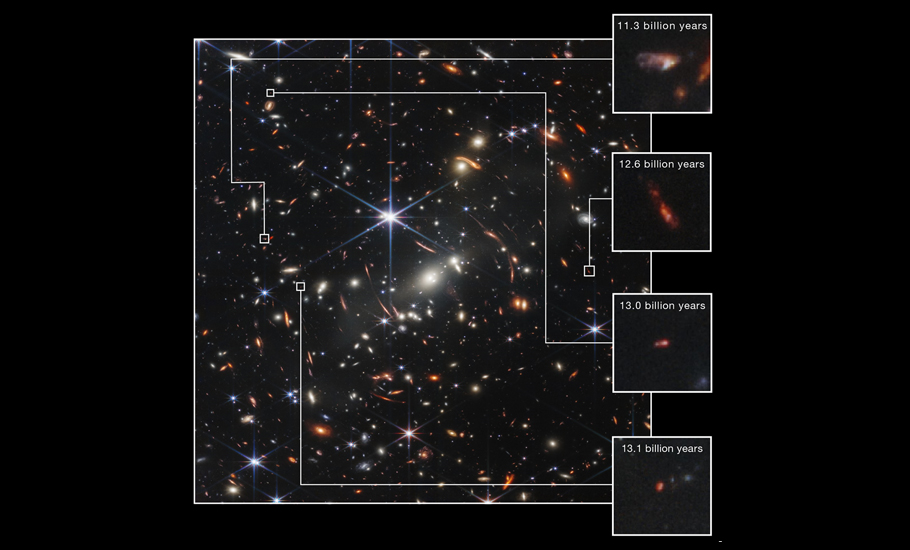
The combined gravity of the cluster acts like a ‘gravitational lens’. Like a lens focus the faint, fuzzy background into a sharp image, this cosmic gravitational lens brings to focus the light from the distant stellar objects in the background. Thus it enables us to peer deeper across space and time. Hence this cluster has been a point of interest for astronomers in studying the early universe.
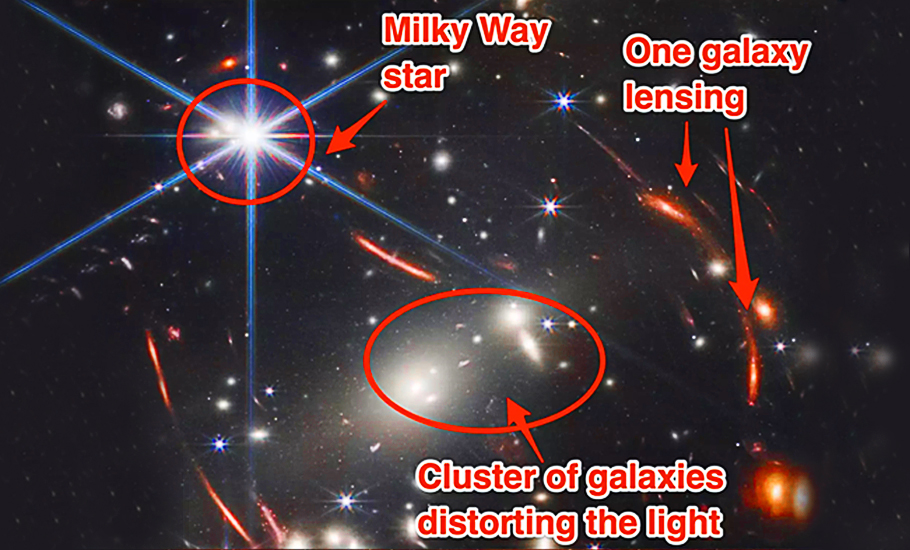
Gravitational lensing
- According to general theory of relativity of Albert Einstein, light bends near a massive object. Imagine light rays from a distant stellar object and a massive object in between. The rays will bend around the massive object before reaching us. As one light ray could bend and reach us from one direction and another from another direction, there will be multiple images of the distant object.
- For example, in the image above, the four bright spots are multiple images of a distant quasar situated 8 billion light-years from the Earth. A quasar is a supermassive black hole gobbling up gas from its galaxy and shining bright in radio waves. This quasar is called Q2237+030. The central blob is a massive galaxy called ZW 2237+030, which is just 400 million light-years away. The distant quasar and the nearer galaxy are so aligned to Earth that the light rays from the quasar bend around the galaxy’s gravitational field and splits into four separate images. The formation is called Einstein Cross. Astronomers have discovered many more instances of gravitational lensing.
The SMACS 0763 galactic cluster acts like a cosmic magnifying glass and is able to bend the light from stellar objects in the background and project it towards the Earth. Therefore some stellar objects appear multiple times, some twisted and distorted.
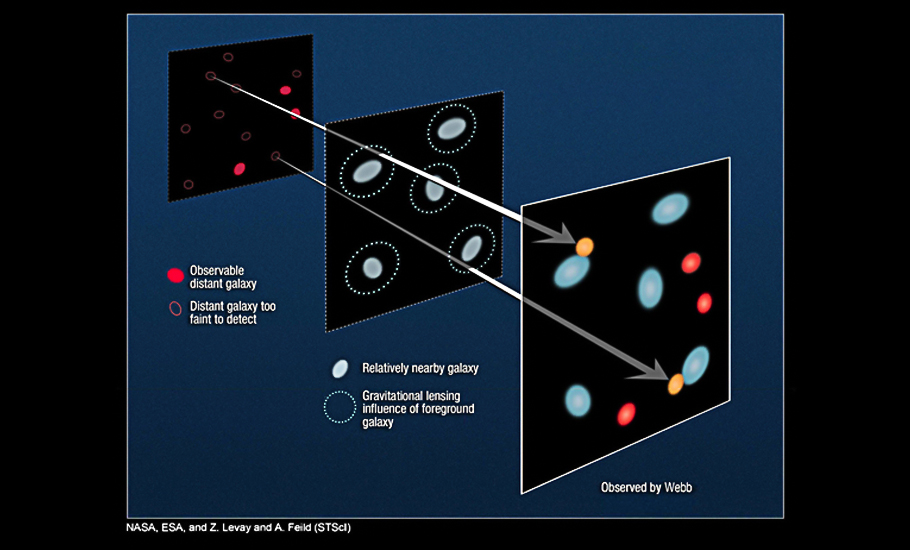
In this zoom-in image, multiple distorted images of the distant galaxy is seen due to gravitational lensing.
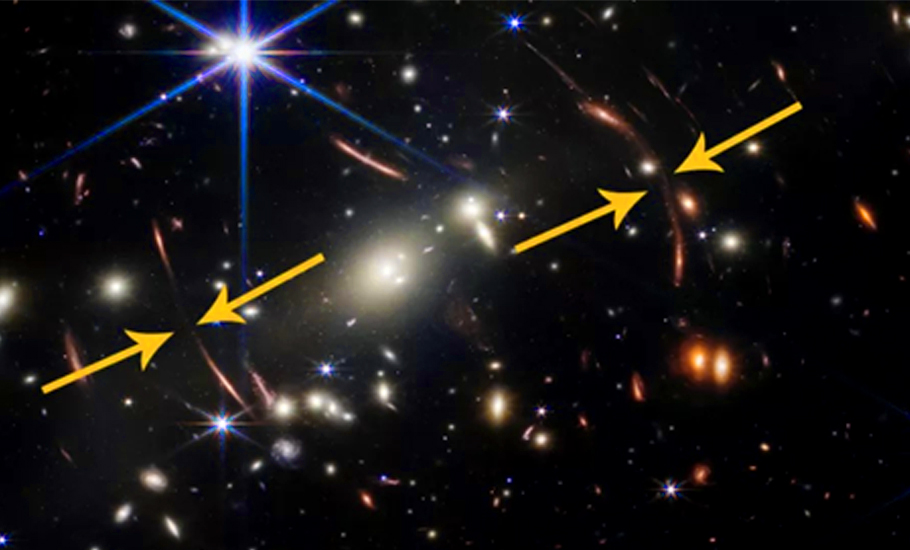
In this zoom-in image we can clearly see a galaxy wrapped by the gravitational lensing and a distant spiral and elliptical galaxy. Rich details like this from distant past will help astronomers fine tune cosmology and how universe evolved.
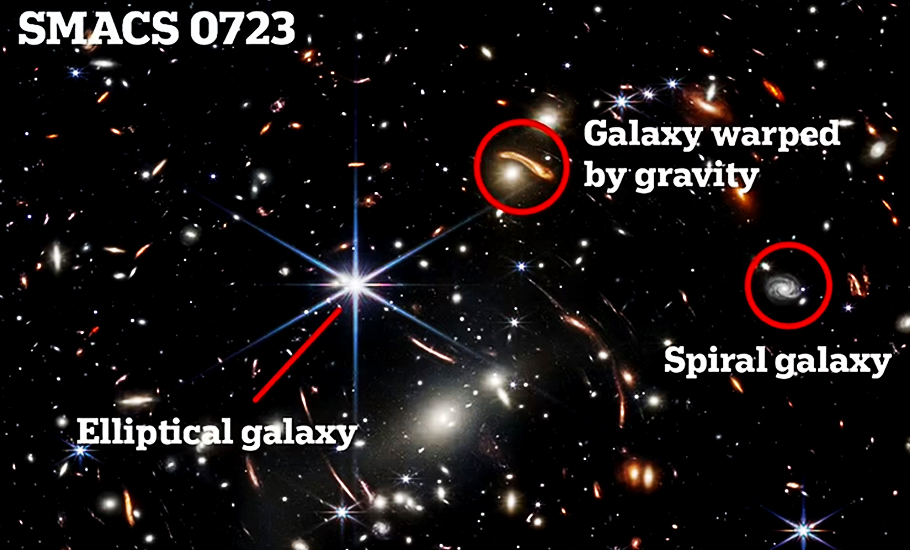
How JWST is able to see back in time
As light travels at about 3,00,000 km in a second it takes a definite time to reach us from distant cosmic objects. Therefore, we see them as they were when the light started its journey. In other words, powerful telescopes enable us to peer into the past of the universe. The farther we look, the farther back in time we see.
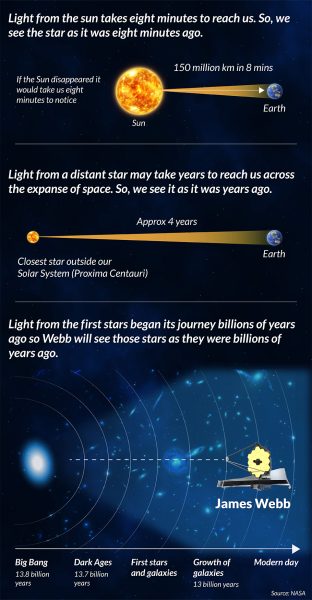
Looking inside a cosmic womb
There are a lot of missing gaps in our understanding of how stars and planets accrete from the thin interstellar medium. Diffused scanty interstellar gas clouds with just 100 atoms per cubic centimetre somehow condense and accrete to form stars with typical densities of 10^22 (one followed by 22 zeros) atoms per cubic centimetre. Once a critical density occurs, the gravity would pull matter around the proto-star can form. But how the required critical density is achieved in large interstellar clouds is yet a mystery.
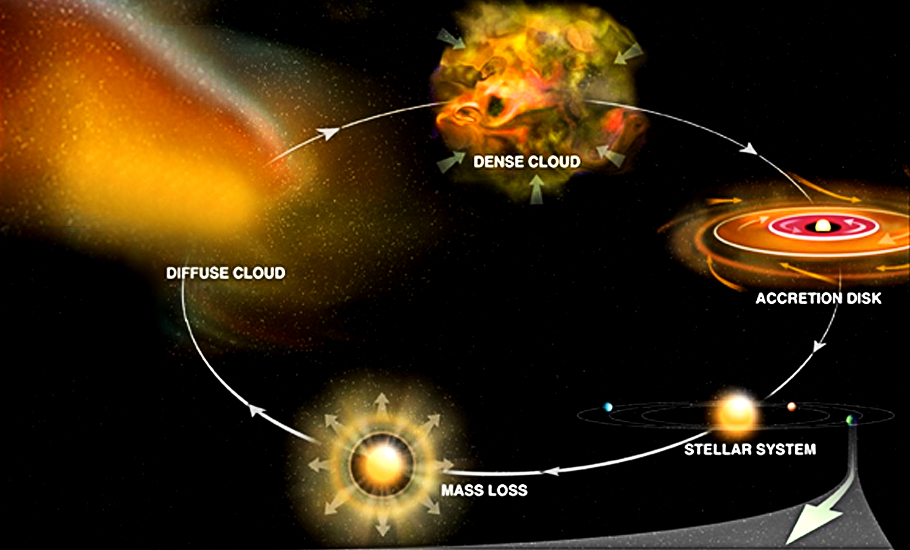
One such stellar nursery booming with new stars is a giant interstellar gas cloud in our galaxy called NGC 3324, located in the direction of the Carina Nebula. The stunning image of an edge of NGC 3324, dubbed Cosmic Cliff, located approximately 7,600 light-years from Earth, is home to many massive and young stars than our Sun. With the giant gas cloud condensing into new stars, this region is active star-forming.
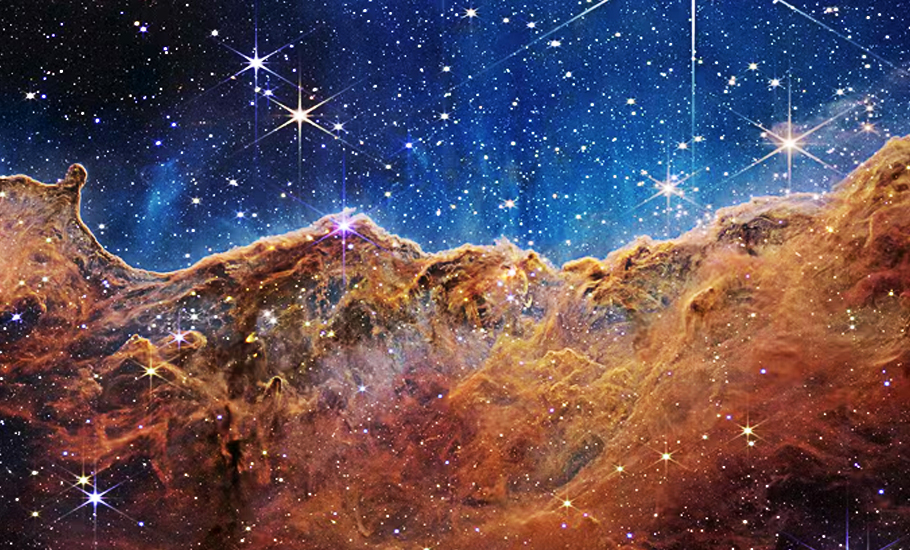
The Carina Nebula (catalogued as NGC 3372) is a region of giant gas and several star clusters located in the direction of constellation Carina. It is seen from the Southern Hemisphere. The nebula is huge, about 500 light-years across and is about 7,600 light-years away from Earth. On the top of the nebula there is a striking bubble like structure. At the centre of the bubble there are hot massive young stars. When stars shine, they emit not only light but also charged particles called as stellar winds. Part of the radiation emitted is also in ultraviolet (UV) rays. The intense stellar winds and UV radiation has created a bubble like cavity. JWST zoomed into a small edge of the bubble called as ‘ Cosmic Cliffs’
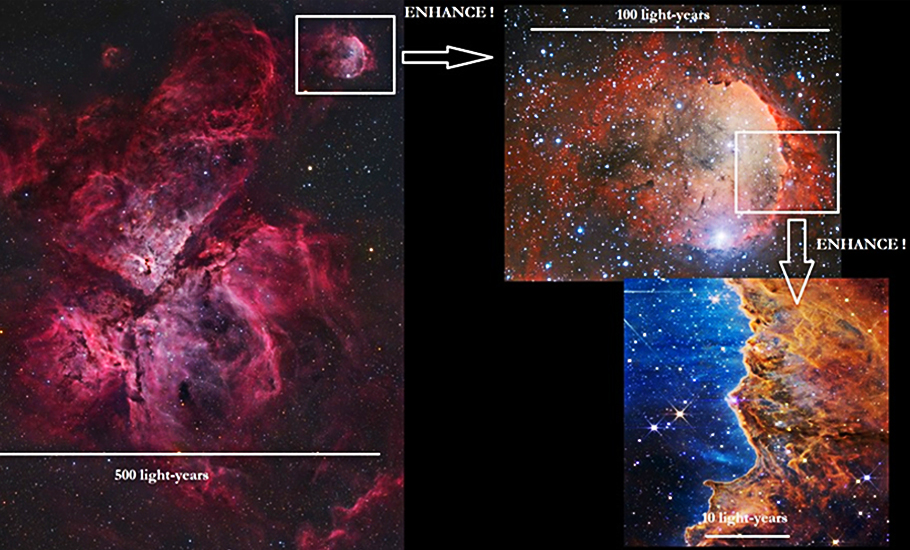
Intense radiation from the newborn stars create bubble like structures in the interstellar cloud.
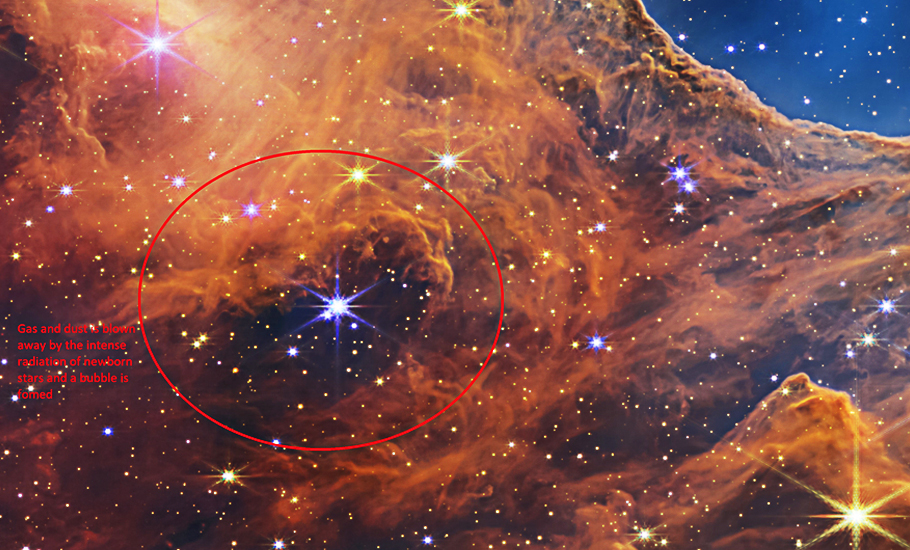
Newborn stars eject jets. They look like golden comets.
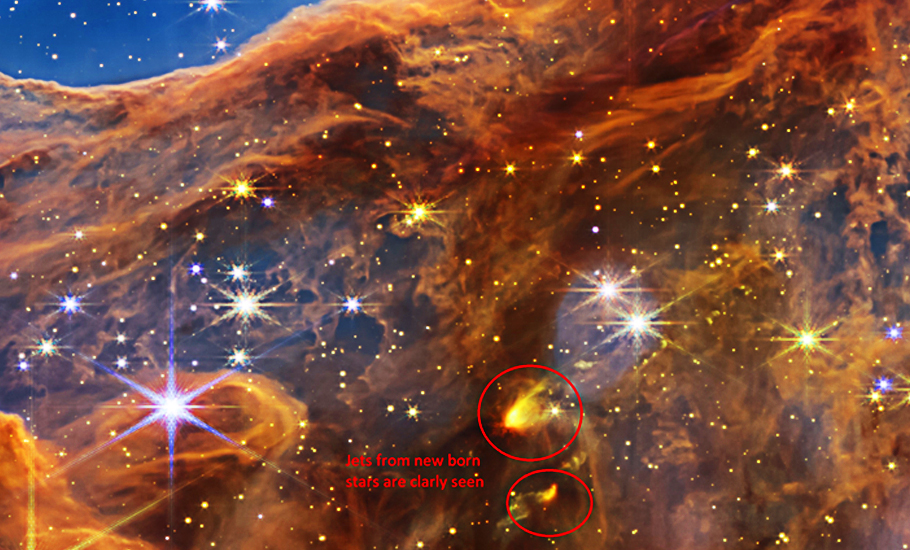
We can learn a lot by closely looking at star-forming regions such as NGC 3324. However, star-forming areas are typically shrouded in a veil of dust and haze. Visible light cannot penetrate and come out of it. However, hot dust and clouds emit infrared rays, which can be detected by the JWST. Like scans reveal the growing fetus, the IR probes of JWST show the gas clouds giving birth to young infant stars.
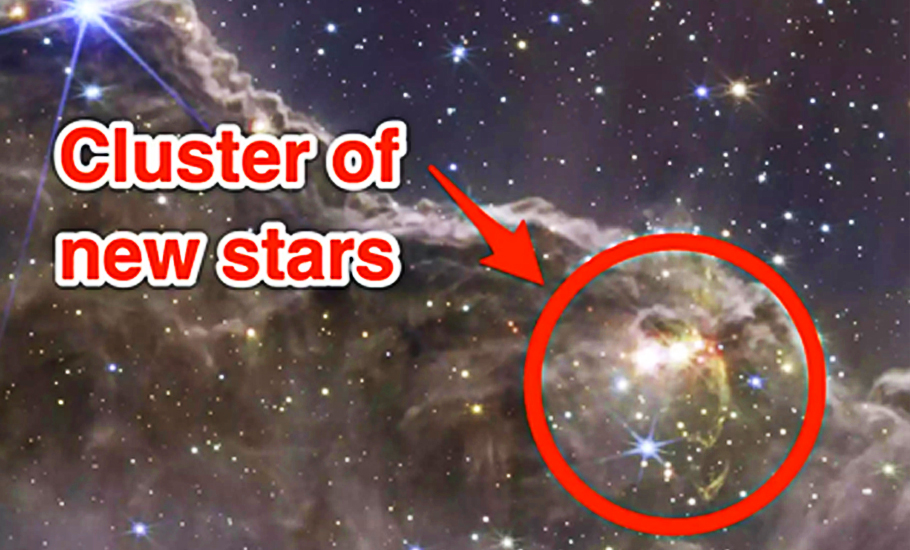
This three-panel image shows the view of the Carina Nebula’s “cosmic cliffs” as seen by Hubble (top), JWST’s NIRCam instrument (middle), and JWST’s MIRI instrument (bottom). With Infrared, JWST is able to look inside the dust and haze to see baby stars in this star-formation region.
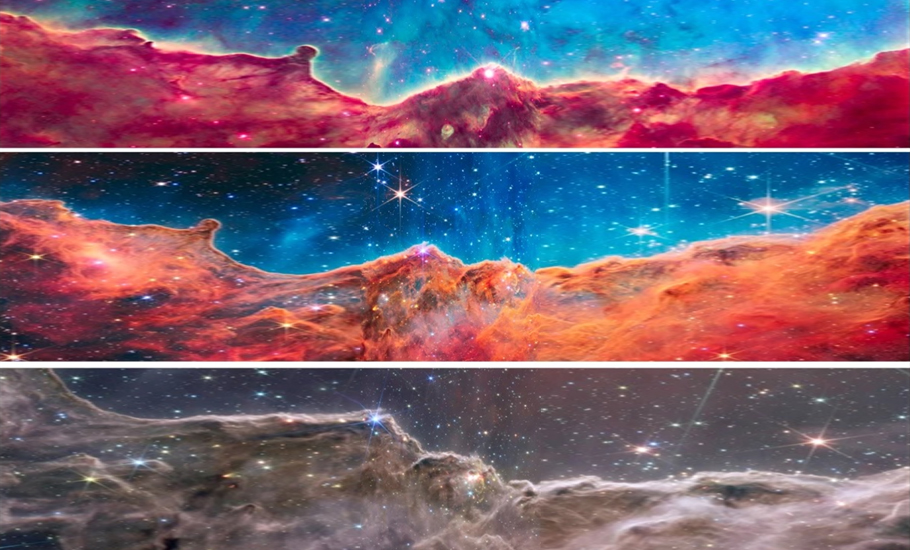
Star death
Imagine a pot of water covered with a lid kept on the fire. The lid lifts and releases the steam as the steam pressure builds up. Once again, steam builds up, and the cover lifts. The process repeats again and again. Likewise, stars with mid-mass, such as Sun, undergo a repeated expansion and contraction. First, the hydrogen in the core fuse to become helium. Once the level of hydrogen falls below a certain level at the centre, the thermonuclear reaction shuts down. With no radiation pressure to counter, the core of the star contracts due to self-gravity. Once the pressure in the contracting core builds up, the helium fuse to make carbon. Each time the core contract, the surface mass is ejected. Each of the ejected shells expands into space like a concentric circle.
(Planetary nebula have nothing to do with planets. Once upon a time, looking through not so powerful telescope, astronomers thought that these were nebula condensing into planets. Therefore the name ‘planetary nebula’.)
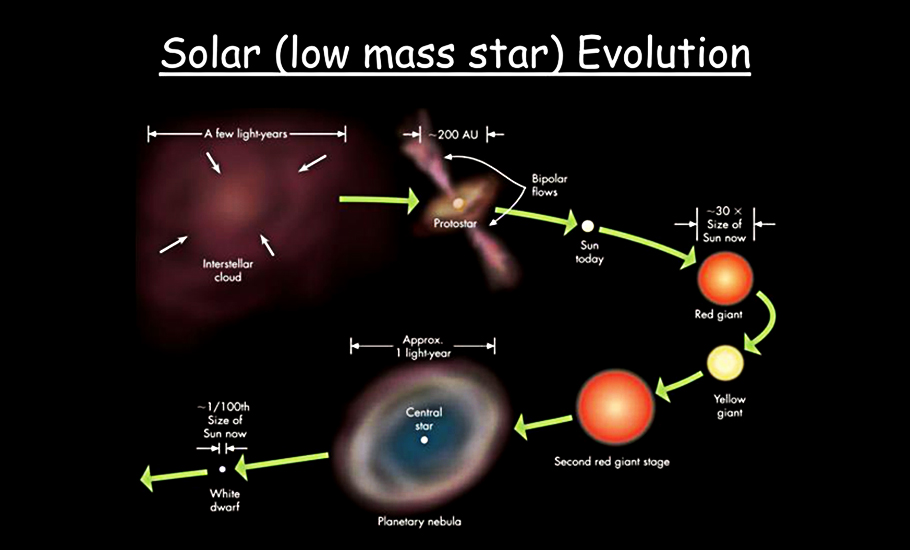
Eight-Burst Nebula, also known as Southern Ring Nebula or NGC 3132, is a well-known planetary nebula in the constellation Vela, located approximately 2,500 light-years from Earth. The JWST captured the expanding ejected shells vividly. The consecutive waves of expelled shells can be clearly seen. The two images are in near-infrared light (left) and mid-infrared light (right).
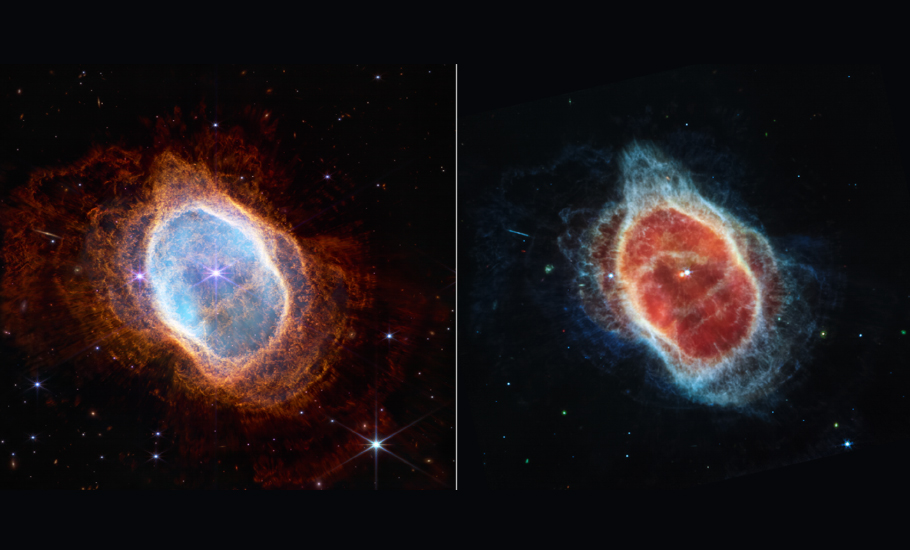
With the dying star in the middle is surrounded by the ionised gas ejected by it. The dust cloud expelled by the star just before dying appear like concentric shell around it. Accidentally, a side way view of a distant galaxy was also seen in this image. Astronomers will closely examine the images and tease out many features in the days to come.
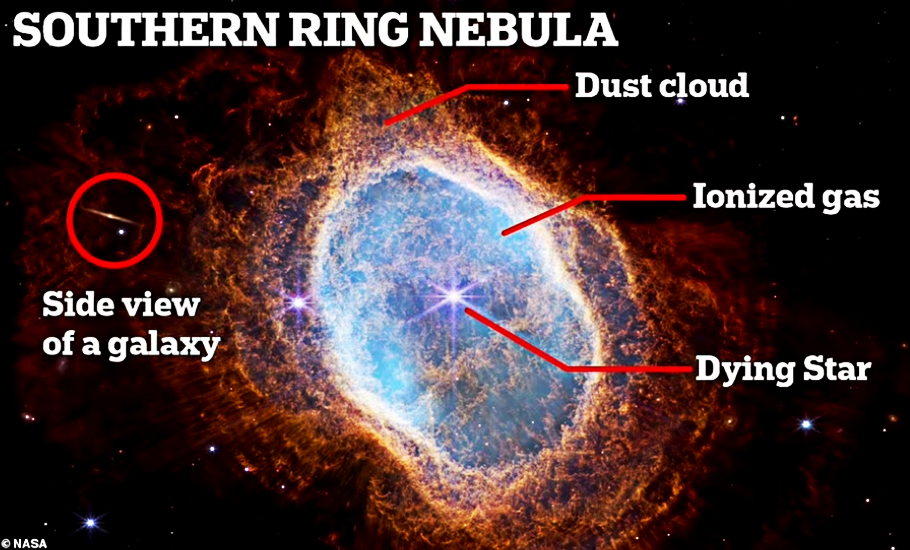
Only one star is visible in the near-infra image on the left, but two in the mid-infra image on the right. These two stars are twin stars, and the less bright one has become a white dwarf star after expelling its outer layers in several ejections. For the first time, we can image the second star hidden behind the dust clouds clearly.
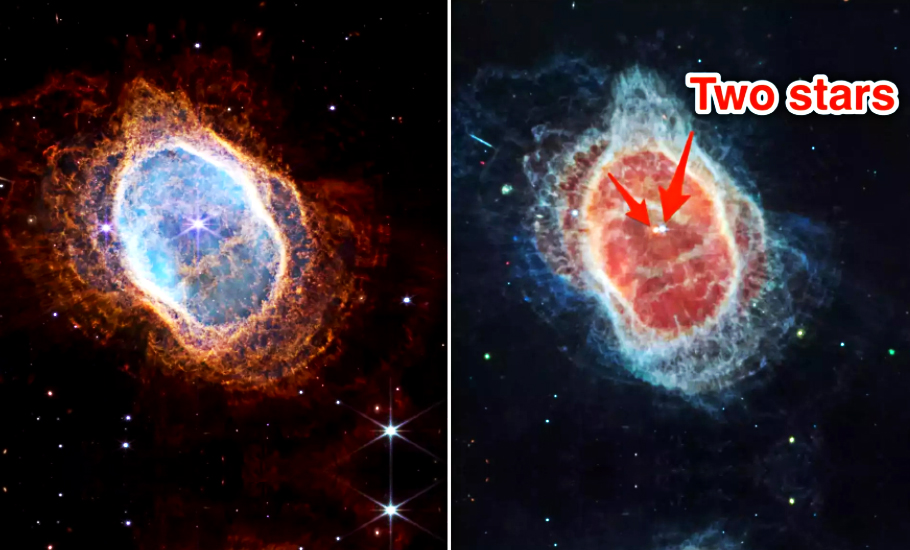
Cosmic cataclysmic collision
Around 290 million light-years from Earth is the clutch of five galaxies, each bound with the others called Stephan’s Quintet. Four of these close-knit galaxies are in a sort of dangerous waltz dance. They are gravitationally bound to each other.
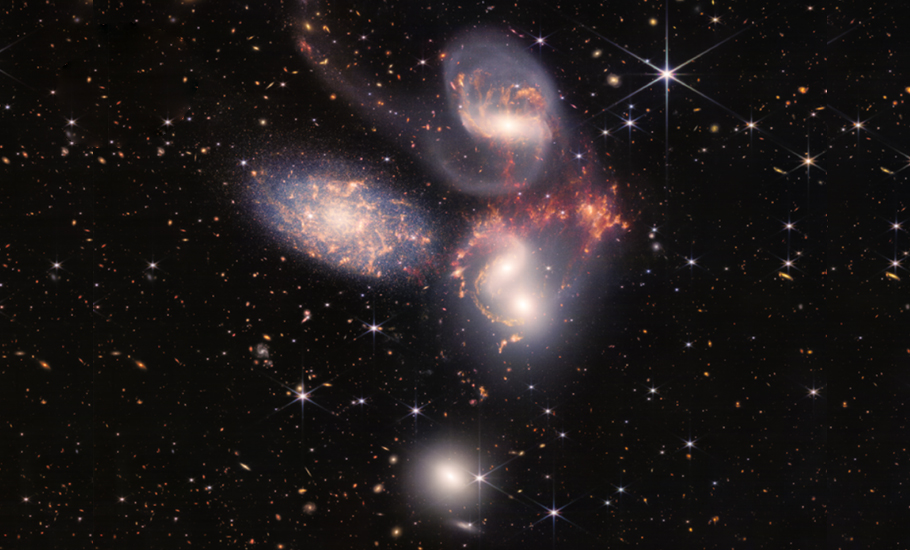
While the NGC 7318a and NGC7318b are colliding and merging into one, NGC 7319 and NGC 7320 are dancing around them. NGC7317 is in the field of view, but not part of the system.
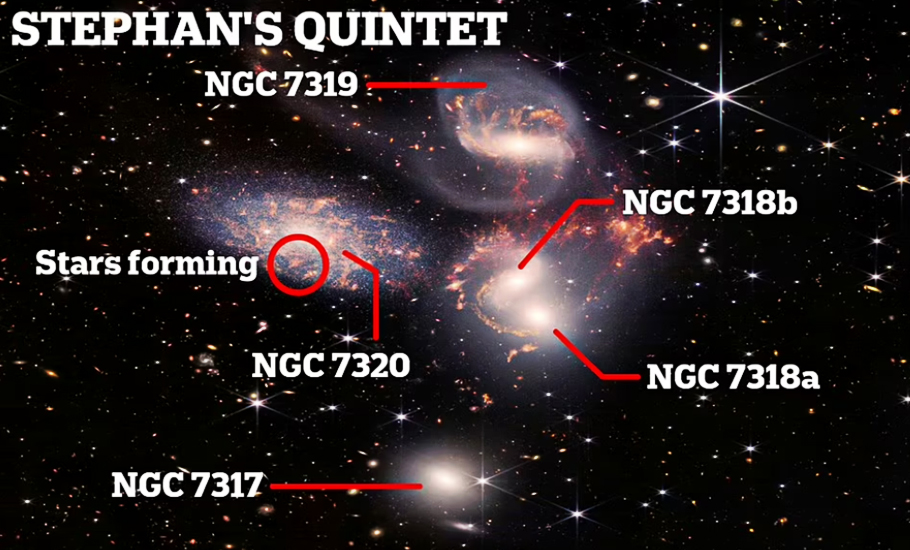
Two of them are currently in the process of merging into one another. Studying such cataclysmal galactic interactions will help us understand how these lead to star formation, evolution, and central black holes in galaxies.
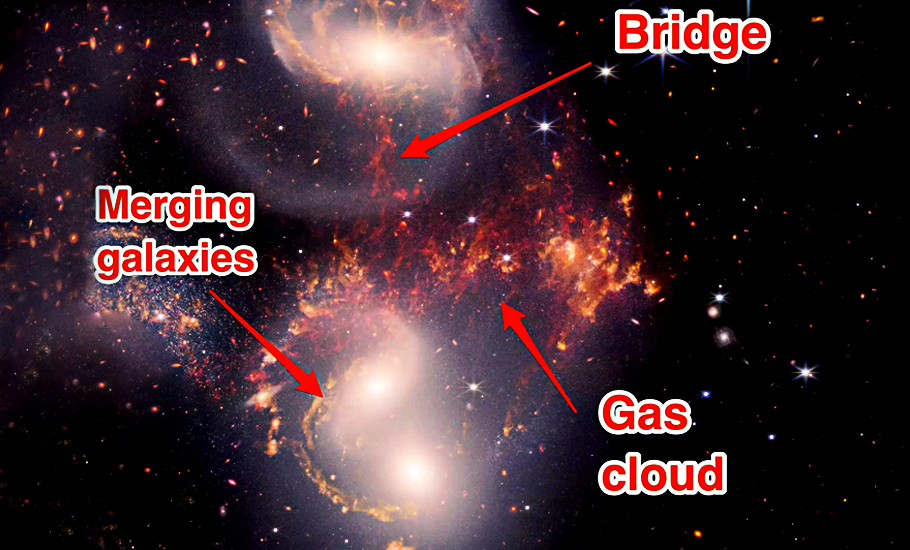
Due to the merger, the new stars are seen to be born in the interstellar gas clouds. Such evidence from across the universe will help us understand how early stars formed.
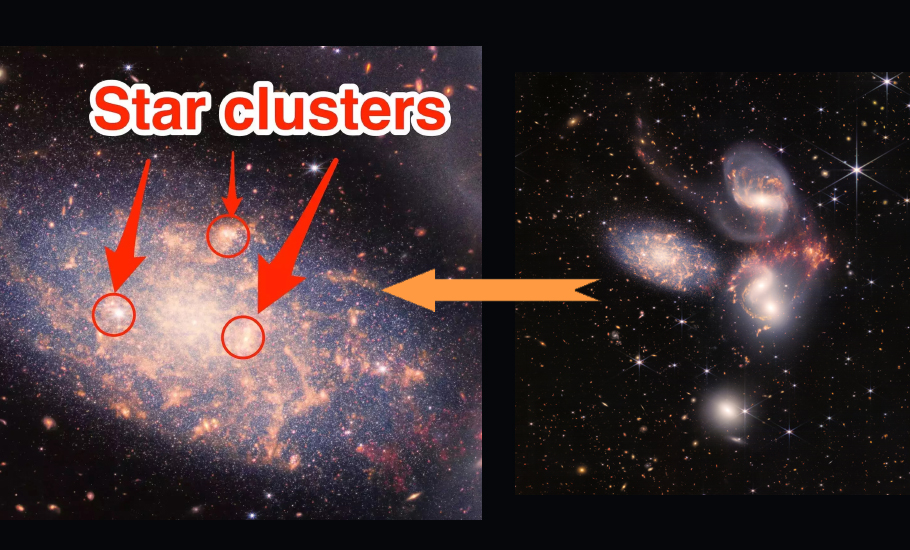
Are we alone?
WASP-96 is a Sun-like star. It is around 1150 light-years from Earth in the constellation of Phoenix. In 2013Wide Angle Search for Planets (WASP) was discovered near Jupiter’s size planet, called WASP-96b orbiting the central star in just 3.4 days. The JWST captured the star’s spectrum and the starlight passing through the atmosphere of the exoplanet WASP-96.
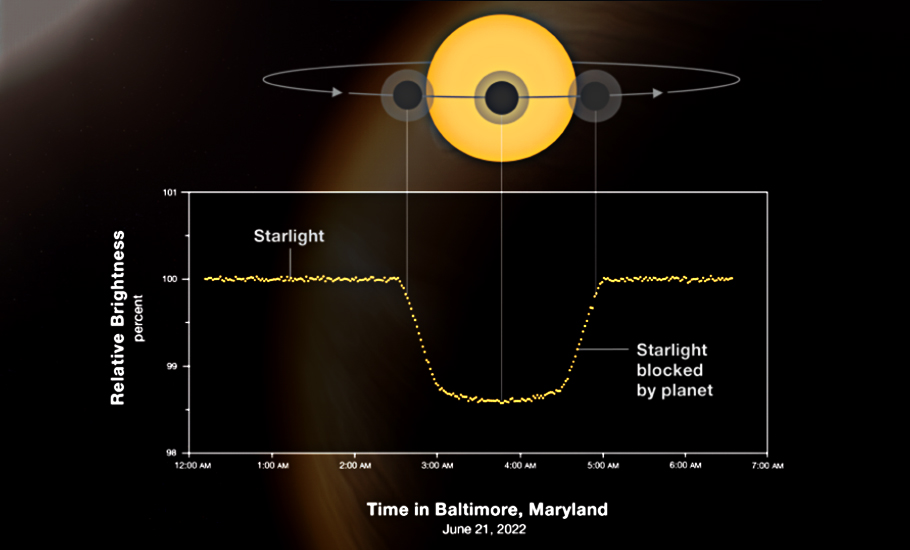
When an element is a hot gas in a star, it appears as a bright line in the spectrum. If an element is a cold gas surrounding a luminous body, it appears as a black line. Like a barcode, the dark and bright lines in the spectrum tell us the star’s composition and the planet’s atmosphere. JWST examined the light coming through the atmosphere. The spectrum clearly shows the presence of water in the planet’s atmosphere.
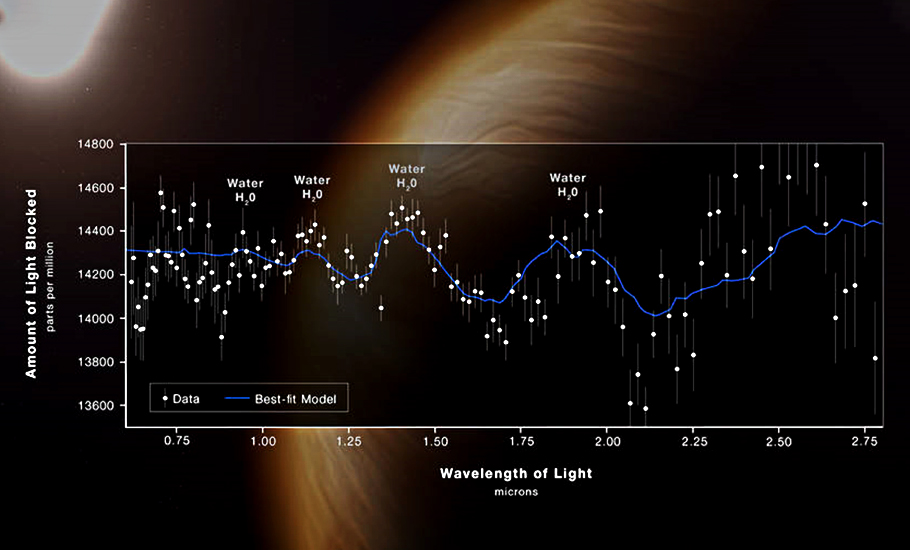
Some of the compounds in the atmosphere can be a tell-tale biosignature for the presence of life on the planet. JWST is expected to shed light on if there is potential life elsewhere in the universe.
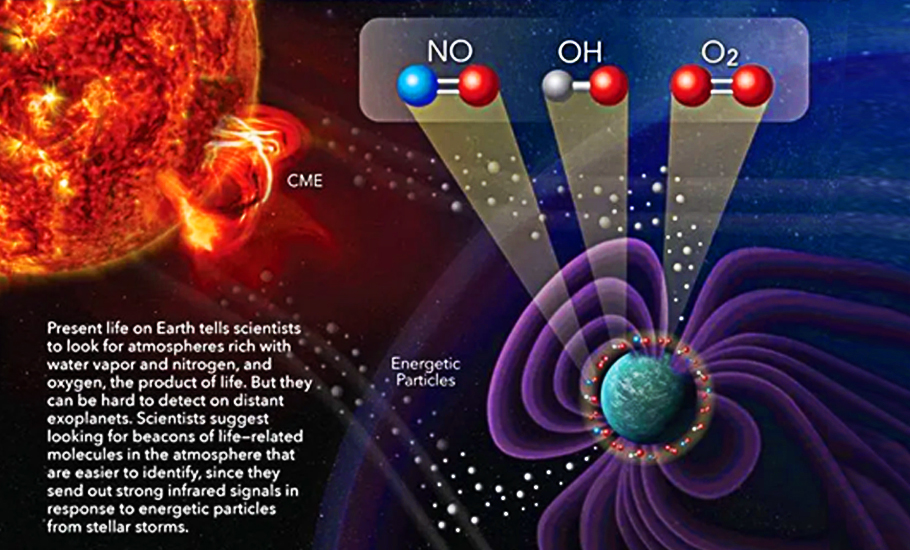
Just a teaser, more to come
Hold a small grain of sand in your hand at arms length, that is the size of the sky this image taken by JWST captures. To cover the entire sky we would need 25 million such images. In the next 10 years of its operation, JWST would zoom into exciting features of the cosmos and will give us a more detailed, and perhaps, a totally new perspective on the cosmos.
